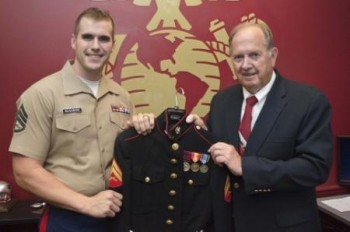 PHOTO: Marine Corps Staff Sgt. Max G. Neighbors, a canvassing recruiter with Recruiting Station Baltimore, and Robert L. Thomas and his Marine Corps dress blues jacket at Recruiting Sub-Station Salisbury, Md., July 21, 2014. U.S. Marine Corps photo by Sgt Bryan J. Nygaard SALISBURY, Md. – The Marines at Recruiting Sub-Station Salisbury here work over 60 hours every week to recruit highly qualified men and women into the Marine Corps. When they are not out canvassing the local community looking for future Marines, they are in the office making phone calls, interviewing applicants and processing paperwork. Their office frequently receives visitors who do not want to join the Marine Corps -- they just want to talk about it. These are former Marines, most of whom served before the recruiters were even born, who stop by the office to talk about their Marine Corps experiences. The recruiters will turn away from their computer screens and listen to stories about the “Old Corps.” Many of these Marine veterans even bring in books and keepsakes from their time in the service and initiate impromptu show and tell sessions in the recruiting office. Once they are finished sharing their fond memories of being one of the few and the proud, they thank the recruiters for their time, shout “OO-RAH!” or “Semper Fi!” as they leave, usually to return with a new story to share. One of these storytellers is Robert Thomas.
PHOTO: Marine Corps Staff Sgt. Max G. Neighbors, a canvassing recruiter with Recruiting Station Baltimore, and Robert L. Thomas and his Marine Corps dress blues jacket at Recruiting Sub-Station Salisbury, Md., July 21, 2014. U.S. Marine Corps photo by Sgt Bryan J. Nygaard SALISBURY, Md. – The Marines at Recruiting Sub-Station Salisbury here work over 60 hours every week to recruit highly qualified men and women into the Marine Corps. When they are not out canvassing the local community looking for future Marines, they are in the office making phone calls, interviewing applicants and processing paperwork. Their office frequently receives visitors who do not want to join the Marine Corps -- they just want to talk about it. These are former Marines, most of whom served before the recruiters were even born, who stop by the office to talk about their Marine Corps experiences. The recruiters will turn away from their computer screens and listen to stories about the “Old Corps.” Many of these Marine veterans even bring in books and keepsakes from their time in the service and initiate impromptu show and tell sessions in the recruiting office. Once they are finished sharing their fond memories of being one of the few and the proud, they thank the recruiters for their time, shout “OO-RAH!” or “Semper Fi!” as they leave, usually to return with a new story to share. One of these storytellers is Robert Thomas.Meet Your Military
- Details
- Hits: 2473
 PHOTO: Marine Corps Staff Sgt. Max G. Neighbors, a canvassing recruiter with Recruiting Station Baltimore, and Robert L. Thomas and his Marine Corps dress blues jacket at Recruiting Sub-Station Salisbury, Md., July 21, 2014. U.S. Marine Corps photo by Sgt Bryan J. Nygaard SALISBURY, Md. – The Marines at Recruiting Sub-Station Salisbury here work over 60 hours every week to recruit highly qualified men and women into the Marine Corps. When they are not out canvassing the local community looking for future Marines, they are in the office making phone calls, interviewing applicants and processing paperwork. Their office frequently receives visitors who do not want to join the Marine Corps -- they just want to talk about it. These are former Marines, most of whom served before the recruiters were even born, who stop by the office to talk about their Marine Corps experiences. The recruiters will turn away from their computer screens and listen to stories about the “Old Corps.” Many of these Marine veterans even bring in books and keepsakes from their time in the service and initiate impromptu show and tell sessions in the recruiting office. Once they are finished sharing their fond memories of being one of the few and the proud, they thank the recruiters for their time, shout “OO-RAH!” or “Semper Fi!” as they leave, usually to return with a new story to share. One of these storytellers is Robert Thomas.
PHOTO: Marine Corps Staff Sgt. Max G. Neighbors, a canvassing recruiter with Recruiting Station Baltimore, and Robert L. Thomas and his Marine Corps dress blues jacket at Recruiting Sub-Station Salisbury, Md., July 21, 2014. U.S. Marine Corps photo by Sgt Bryan J. Nygaard SALISBURY, Md. – The Marines at Recruiting Sub-Station Salisbury here work over 60 hours every week to recruit highly qualified men and women into the Marine Corps. When they are not out canvassing the local community looking for future Marines, they are in the office making phone calls, interviewing applicants and processing paperwork. Their office frequently receives visitors who do not want to join the Marine Corps -- they just want to talk about it. These are former Marines, most of whom served before the recruiters were even born, who stop by the office to talk about their Marine Corps experiences. The recruiters will turn away from their computer screens and listen to stories about the “Old Corps.” Many of these Marine veterans even bring in books and keepsakes from their time in the service and initiate impromptu show and tell sessions in the recruiting office. Once they are finished sharing their fond memories of being one of the few and the proud, they thank the recruiters for their time, shout “OO-RAH!” or “Semper Fi!” as they leave, usually to return with a new story to share. One of these storytellers is Robert Thomas.Read more: Meet Your Military: Marine Corps Vet Recalls Experiences
- Details
- Hits: 2015
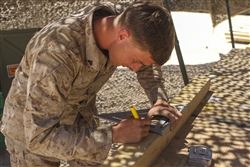 PHOTO: Marine Corps Cpl. Tanner Lechner measures wood for a “gear tree” during Large Scale Exercise 2014 at Marine Corps Air Ground Combat Center Twentynine Palms, Calif., Aug. 4, 2014. MARINE CORPS AIR GROUND COMBAT CENTER TWENTYNINE PALMS, Calif., Aug. 11, 2014 – On an uncomfortably hot day in the Mojave Desert, many service members participating in Large Scale Exercise 2014 were preparing for the day to end.A gear tree is for storing body armor and a helmet. The bilateral training is building U.S. and Canadian forces’ joint capabilities. U.S. Marine Corps photo by Lance Cpl. Angel Serna But one Marine decided it was the perfect weather to bring out his tools and some spare wood to create something from scraps of nothing. Cpl. Tanner Lechner, a combat engineer with Combat Service Support Company, 1st Brigade Headquarters Group, 1st Marine Expeditionary Brigade, said he enjoys his time out in the field regardless of the weather, because he gets to practice and improve his construction and creativity skills. Before he joined the Marine Corps, Lechner lived in Topeka, Kansas, up to his early adulthood. After high school, he said, he wanted to take charge of his life and do something he enjoys.
PHOTO: Marine Corps Cpl. Tanner Lechner measures wood for a “gear tree” during Large Scale Exercise 2014 at Marine Corps Air Ground Combat Center Twentynine Palms, Calif., Aug. 4, 2014. MARINE CORPS AIR GROUND COMBAT CENTER TWENTYNINE PALMS, Calif., Aug. 11, 2014 – On an uncomfortably hot day in the Mojave Desert, many service members participating in Large Scale Exercise 2014 were preparing for the day to end.A gear tree is for storing body armor and a helmet. The bilateral training is building U.S. and Canadian forces’ joint capabilities. U.S. Marine Corps photo by Lance Cpl. Angel Serna But one Marine decided it was the perfect weather to bring out his tools and some spare wood to create something from scraps of nothing. Cpl. Tanner Lechner, a combat engineer with Combat Service Support Company, 1st Brigade Headquarters Group, 1st Marine Expeditionary Brigade, said he enjoys his time out in the field regardless of the weather, because he gets to practice and improve his construction and creativity skills. Before he joined the Marine Corps, Lechner lived in Topeka, Kansas, up to his early adulthood. After high school, he said, he wanted to take charge of his life and do something he enjoys.
His life-changing decision was inspired by his grandfather, who retired as a captain from the Marine Corps, Lechner said. His grandfather’s stories of his career motivated him to the point that he decided to join the Marine Corps in 2011, he added. “I picked combat engineer as my [specialty] when I joined,” the 21-year-old Marine said. “It wasn’t my first choice, but I couldn’t do reconnaissance, because I was color blind. My recruiter mentioned to me, ‘As a combat engineer, you’ll get to build things and blow stuff up,’ so I said, ‘Yeah! Put me there.’” After graduating from recruit training and his specialty school, Lechner said, he moved on to the operational forces, which gave him the opportunity to deploy and conduct his job. “We made what [we] would call a ‘triple-nickel 40’ out of cratering charges on a partially dry lake bed in the Philippines,” he said. “When this thing went off, it made this massive crater, and all of the water that was underground came rushing in. It instantly filled with water, and we were like, ‘Hey, we made a big pond.’”
Read more: Meet Your Military: Combat Engineer Practices Skills in Exercise
- Details
- Hits: 2025
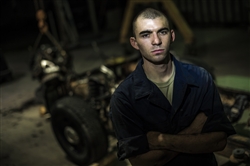 PHOTO: Senior Airman Christopher Moore has been a mechanic for the Air Force for three years and is deployed to Southwest Asia from the 86th Vehicle Readiness Squadron, Ramstein Air Base, Germany, in support of Operation Enduring Freedom. U.S. Air Force photo by Staff Sgt. Jeremy Bowcock SOUTHWEST ASIA – What little boy doesn't like ripping apart his toys and making a mess of things? But the older most men get, the more expensive and fancier the toys become. Air Force Senior Airman Christopher Moore, a vehicle mechanic with the 386th Expeditionary Logistics Readiness Squadron, is no exception. When it comes to tinkering and fixing things, he has a passion and curiosity for it all. Now, his toys are much bigger than they were when he was a boy, and they belong to the Air Force. "Working on cars brings a sense of pride when you see what you've fixed," Moore said. "I recently replaced the engine in a truck. It took three days to take apart the entire vehicle, but it felt good to hear the engine fire up and to watch it drive away." He said he likes to challenge himself and feels confident in his skills to try new projects and learn from them.
PHOTO: Senior Airman Christopher Moore has been a mechanic for the Air Force for three years and is deployed to Southwest Asia from the 86th Vehicle Readiness Squadron, Ramstein Air Base, Germany, in support of Operation Enduring Freedom. U.S. Air Force photo by Staff Sgt. Jeremy Bowcock SOUTHWEST ASIA – What little boy doesn't like ripping apart his toys and making a mess of things? But the older most men get, the more expensive and fancier the toys become. Air Force Senior Airman Christopher Moore, a vehicle mechanic with the 386th Expeditionary Logistics Readiness Squadron, is no exception. When it comes to tinkering and fixing things, he has a passion and curiosity for it all. Now, his toys are much bigger than they were when he was a boy, and they belong to the Air Force. "Working on cars brings a sense of pride when you see what you've fixed," Moore said. "I recently replaced the engine in a truck. It took three days to take apart the entire vehicle, but it felt good to hear the engine fire up and to watch it drive away." He said he likes to challenge himself and feels confident in his skills to try new projects and learn from them.
Moore grew up in Lebanon, Missouri, with his father after his parents divorced. He was 13, when he started working as a floor sweeper at a salvage yard. Throughout his teenage years, he spent his time working at his father's vehicle restoration shop, where he developed his skill for working on cars. In college, he worked as a mechanic at a major automotive business and continued to refine his maintenance skills. "I went to college for two years, taking classes such as marine biology, science and other subjects, but I was really drawn to auto mechanics," said Moore, who is deployed from Ramstein Air Base, Germany.
Read more: Meet Your Military: Vehicle Mechanic Brings Passion to His Service
- Details
- Hits: 2628
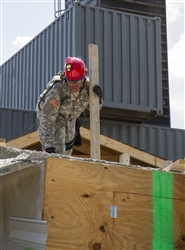 PHOTO: Army Pfc. Erica Haynes prepares to perform an extraction during the Vibrant Response 14 exercise at Camp Atterbury Joint Maneuver Training Center, Ind., Aug. 2, 2014. CAMP ATTERBURY, Ind. – On a hot Saturday afternoon, Army Pfc. Erica Haynes of the Alabama National Guard’s 440th Chemical Company skillfully maneuvers over the debris of a collapsed structure, searching for survivors of a simulated nuclear explosion. U.S. Army photo by Sgt. Dani Salvatore This Aug. 2 search and extraction exercise was the first training session for her unit at Vibrant Response 14 at the Camp Atterbury Joint Maneuver Training Center here. Vibrant Response is a U.S. Northern Command-sponsored, U.S. Army North-led field training exercise for chemical, biological, radiological, nuclear and high-yield explosive consequence management forces. It is designed to improve their ability to respond to catastrophic incidents. “Is anybody in here?” Haynes called out as she struggled to find her footing on the unstable rubble. “Is anybody in here?” On a hunch that someone could be trapped inside the structure below her, Haynes grabbed a large plank and began pounding the surface beneath her. “Can you hear me?” she exclaimed. “If you can, knock back!”
PHOTO: Army Pfc. Erica Haynes prepares to perform an extraction during the Vibrant Response 14 exercise at Camp Atterbury Joint Maneuver Training Center, Ind., Aug. 2, 2014. CAMP ATTERBURY, Ind. – On a hot Saturday afternoon, Army Pfc. Erica Haynes of the Alabama National Guard’s 440th Chemical Company skillfully maneuvers over the debris of a collapsed structure, searching for survivors of a simulated nuclear explosion. U.S. Army photo by Sgt. Dani Salvatore This Aug. 2 search and extraction exercise was the first training session for her unit at Vibrant Response 14 at the Camp Atterbury Joint Maneuver Training Center here. Vibrant Response is a U.S. Northern Command-sponsored, U.S. Army North-led field training exercise for chemical, biological, radiological, nuclear and high-yield explosive consequence management forces. It is designed to improve their ability to respond to catastrophic incidents. “Is anybody in here?” Haynes called out as she struggled to find her footing on the unstable rubble. “Is anybody in here?” On a hunch that someone could be trapped inside the structure below her, Haynes grabbed a large plank and began pounding the surface beneath her. “Can you hear me?” she exclaimed. “If you can, knock back!”
A muffled reply from below cried out for help. Haynes was prepared to do whatever it took to rescue the survivor. Search and extraction is her favorite skill to perform, she said. “You have to think off the top of your head, and you never know what to expect,” she explained. A survivor’s injuries and the integrity of the structure can complicate the extraction, she added, thus requiring a great deal of thought and skill to perform the rescue. “Are you hurt?” Haynes called out to the role-playing survivor trapped below her. The survivor’s right leg was injured, and he was unable to move it. Because he couldn’t move, Haynes and her team were unable to cut through the structure to perform the rescue without risking further injury to the survivor. This situation did not discourage Haynes, and she began searching for another way to extract the survivor.
Read more: Meet Your Military: Soldier Practices Search, Extraction
- Details
- Hits: 2041
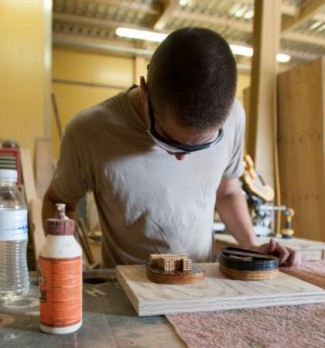 PHOTO: Army Spc. David Beachey from Highland, Ind., who serves with the 1413th Engineer Company, Indiana National Guard, examines his work in the woodshop at Kandahar Airfield, Afghanistan, July 26, 2014. KANDAHAR AIRFIELD, Afghanistan – The road to becoming a leader could be considered a long one. While some soldiers march along, others charge up the road. Beachey, the primary sign maker, works for Army Spc. Keith Harris, the shop’s leader. U.S. Army photo by Spc. Ariel J. Solomon Army Spc. Keith Harris of the Indiana National Guard’s 1413th Engineer Company has been earning leadership positions since he attended basic training. Harris is in charge of his unit’s woodshop here. He leads several soldiers, each with varying amounts of woodworking knowledge. It's his job to form this group into a team and ensure their tasks are accomplished to the highest possible standard.
PHOTO: Army Spc. David Beachey from Highland, Ind., who serves with the 1413th Engineer Company, Indiana National Guard, examines his work in the woodshop at Kandahar Airfield, Afghanistan, July 26, 2014. KANDAHAR AIRFIELD, Afghanistan – The road to becoming a leader could be considered a long one. While some soldiers march along, others charge up the road. Beachey, the primary sign maker, works for Army Spc. Keith Harris, the shop’s leader. U.S. Army photo by Spc. Ariel J. Solomon Army Spc. Keith Harris of the Indiana National Guard’s 1413th Engineer Company has been earning leadership positions since he attended basic training. Harris is in charge of his unit’s woodshop here. He leads several soldiers, each with varying amounts of woodworking knowledge. It's his job to form this group into a team and ensure their tasks are accomplished to the highest possible standard.
Harris credits the influence of his friend and mentor Darrell Harvey, because Harvey never gave up on him. Harris explained that he wants to be the same kind of person as he grows older. “Growing up, I wasn't the best kid. I was sent to military schools and boarding schools,” said Harris, who hails from Cicero, Indiana. “For some reason, [Harvey] knew I was doing wrong, but he would just keep pushing me to be a better person. I'd keep saying I would change but never did. It wasn't until the last military school that I decided Darrell was right and that's why I joined the military, because I needed something in my life.” Harris added: "It's like everything he ever said to me suddenly made sense. Ever since then we've been closer than we were when I was growing up.” Harris said the National Guard has given him a place to grow and build his leadership skills. He believes a good leader commands with respect, instead of simply commanding respect.
Army 1st Sgt. Michael Dunn of the 1413th Engineer Company, he said, has been one of his biggest influences in that regard. “I feel we fall from the same tree,” Harris said of Dunn’s leadership style. “I like the way he's able to lead; he doesn't have to yell and scream at people. People just follow him. He walks into a room and people just listen, and that's what I want to be." Harris’ soldiers describe his leadership style as adhering to the core value of selfless service. He puts the needs of his men above his own, taking extra time learning the various jobs and techniques used in the woodshop so that he can effectively train and impart knowledge to his soldiers.
Read more: Meet Your Military: Soldier Leads Troops in Woodshop






